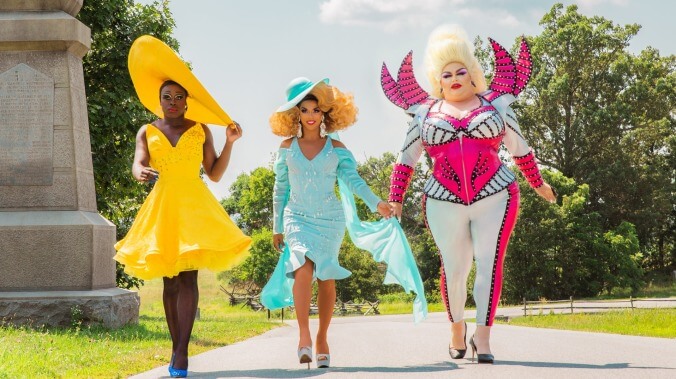We’re Here follows a familiar format. Shangela, Bob, and Eureka roll into town, meet up with a handful of locals they’ll be mentoring, and set to work putting on a one-night-only drag show featuring their new drag daughters. Their mentees run the gamut: Queer artists, straight allies, and repentant former homophobes take to the stage, each for their own reasons. Some have always been curious about drag, some are looking for validation in their community, and others are just excited to put themselves out there and try something new. Emotions come bubbling to the surface as the locals work with their drag mothers and Shangela, Bob, and Eureka each do an excellent job of connecting with their charges. They’re seasoned drag performers, but they’re also reality stars, and they know how to find and sit comfortably in moments of vulnerability.
Every episode begins with the queens walking through the latest small town in full drag, interacting with townspeople and promoting the upcoming show. The hosts’ experiences in these communities are a highlight of the show, from one bystander’s instant recognition and overjoyed reaction upon seeing them to outright hostility from others. There’s a strong sense of place to each episode. Shots of Shangela and Bob eyeing Confederate flags as they walk through one town, or of towering religious monuments in another, provide context for the locals’ experiences and underscore just what it means for a group of queer performers to put on any show, let alone a drag show, in many small towns.
There’s a lot to appreciate in We’re Here. Fans of Queer Eye-style makeover shows will enjoy the drag transformations and heartwarming emotional moments. Fans of Shangela, Bob, and Eureka will be happy to spend more time with these charismatic performers. They have an easy chemistry and it’s a pleasure to watch people dedicated to and skilled in their craft as they work. Perhaps most importantly, though, fans of live entertainment and drag will enjoy the final performances, which are uniformly strong. All three hosts debut extravagant new costumes each episode and they take turns hosting the drag shows. They have distinct styles, which adds variety to the shows, and fans will be excited to see them lip-sync and perform to their own music as well as popular standards with their drag daughters. Some shows are bigger than others, but both the leads and their mentees are in good hands with teams of makeup artists, hair stylists, costumers, and sizable technical crews. As well as hosting, D.J. Pierce (Shangela), Caldwell Tidicue (Bob The Drag Queen), and David Huggard (Eureka O’Hara) have consulting producer credits, and their involvement on the production side shows.
At the core of We’re Here is a celebration of performance as self-expression, and that brings with it questions the series only intermittently engages with. The opportunity to perform in an HBO-produced series with world-famous drag queens is a significant thing. Whose voices deserve to be amplified in this way? Participating in a show like this can be transformational, as is powerfully demonstrated in the third episode, but it can also ring hollow, a grand gesture separated from the daily work necessary to build and sustain relationships. For the locals seeking to change their lives, their performance is one step on a longer path of self-knowledge and community-building, and as the hosts occasionally point out, the hard work lies ahead. The series would benefit from more engagement with this idea, at least with the drag daughters to whom it applies. Thankfully, not all of the performances are quite so heavy, and the balance of drag as joyous celebration versus drag as emotional statement improves as the season continues.
We’re Here is an easy sell to fans of Drag Race. What HBO couldn’t have counted on is how timely the series feels. With much of the world social distancing due to COVID-19, the importance of the arts to connect and bring people together has been underscored, as has the power of live performance. Many viewers are aching for communal experiences and watching not only the locals perform, but their friends and families experience that performance hits in a different way now than it would have a year ago. There is plenty to connect to on a thematic level, from explorations of gender presentation, small town life, and religion to the intersections of queer identity and race, and there’s plenty to connect to on an aesthetic or comedic level. For many right now, though, the opportunity to experience a taste of live performance, with a live audience, is enough of a reason to tune in. Regardless of motivation, or level of drag familiarity, We’re Here is a charming and engaging reality series and one well worth watching.









































